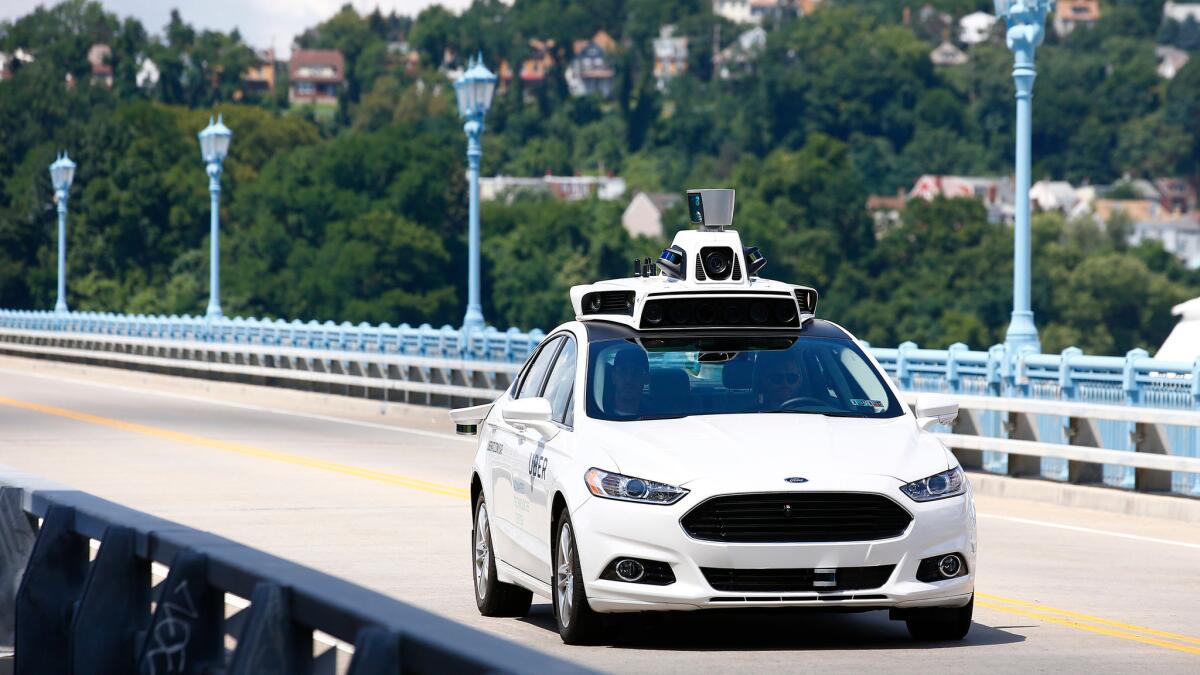Op-Ed: Autonomous vehicles could cost America 5 million jobs. What should we do about it?

Uber employees test a self-driving Ford Fusion hybrid car in Pittsburgh on Aug. 18.
Suddenly the era of driverless cars seems very near indeed. Uber began testing driverless cars in Pittsburgh last week, and this week, the Obama administration endorsed the push to develop these vehicles. Adding to the momentum, Ford and BMW say they will produce autonomous cars by 2021.
Driverless cars will create some big winners — imagine how Uber’s and Lyft’s profits will jump when they can keep 100% of fares instead of letting drivers keep 70%. But they will produce some big losers too, notably the 5 million people nationwide — including 600,000 in California — who make their living driving taxis, buses, vans, trucks and e-hailing vehicles. That’s almost 3% of the workforce, according to Lawrence Katz, a labor economist at Harvard. Incidentally, most of these drivers belong to the same demographic cohort as many factory workers — men without college degrees — who’ve already been hit hard by the loss of 5 million manufacturing jobs since 2000.
“We’re done for,” said John Billington, an Uber driver in Los Angeles. “They just want to get rid of us. What are all these Uber drivers going to do?”
With millions of workers at risk, the government should step in to cushion the blow.
Beyond Uber and Lyft, tech giants such as Google and Apple might make huge profits from managing these vehicles’ elaborate electrical and data systems.
Driverless vehicles could play out much like trade agreements: a boon for corporations and consumers, a bane for many workers. Beyond Uber and Lyft, tech giants such as Google and Apple might make huge profits from managing these vehicles’ elaborate electrical and data systems. Karl Brauer, an auto analyst with Kelley Blue Book, sees a treasure trove for companies that gather data about passengers who use driverless cars: “They will know when he’s going, where he’s going, what he’s doing. Talk about opportunities for targeted advertising.”
For consumers, self-driving vehicles may well mean more choice and lower prices. And these cars will help many Americans in another, underappreciated way. “Most of us in the U.S. commute all alone in a single car. The average driver spends 51 minutes to and from work every day,” said Raj Rajkumar, a professor of computer engineering at Carnegie Mellon. “This is wasted time and wasted productivity. Driverless cars would be a big win for productivity. You can spend 45 minutes doing something productive, including taking a nap.” In traffic-clogged L.A., two hours of commuting time could become additional work time — perhaps leading to more hours of pay or enabling workers to head home earlier each day.
Meanwhile, as giant companies and consumers reap so many benefits, it’s not just the drivers who will suffer. Once self-driving cars grow popular, many households may decide they don’t need to own a car; they can simply e-hail driverless cars to go shopping or take the kids to soccer practice. As a result, many auto dealerships, car washes, gas stations and parking lots might shut down, causing additional layoffs.
It’s not all bad news, though: Unlike with many previous technologies that took Americans almost by surprise, we can see what’s coming, and we have plenty of time to figure out a plan of action.
We could adopt a big, smart retraining program for affected drivers. Granted, in recent years, many lawmakers and laid-off workers have complained that there often aren’t enough jobs for those who’ve labored to learn new skills. Katz says the government should create public-sector jobs so these drivers are not consigned to long-term jobless purgatory.
Laid-off drivers, gas station attendants and others will need help beyond traditional unemployment insurance. Perhaps they should receive adjustment assistance just like factory workers who lost jobs because of imports.
For those wondering where all that money will come from, there’s an obvious source. Uber, Ford, Google and other companies eager to earn billions from driverless cars no doubt will press Congress to enact a law creating a nationwide green light for these cars as well as uniform national regulations. In exchange for enacting such a law — which should happen only when these cars are proved safe — Congress could levy a special tax on each driverless mile to finance programs for retraining, adjustment assistance, unemployment insurance and perhaps government jobs.
The loss of 5 million factory jobs since 2000 has devastated families and communities across the country. The nation could well lose an equal number of driving-related jobs in the next 10 or 20 years, but a similar devastation need not follow.
Steven Greenhouse was the New York Times’ labor and workplace reporter from 1995 to 2014. He is the author of “The Big Squeeze: Tough Times for the American Worker.”
Follow the Opinion section on Twitter @latimesopinion and Facebook
More to Read
A cure for the common opinion
Get thought-provoking perspectives with our weekly newsletter.
You may occasionally receive promotional content from the Los Angeles Times.










